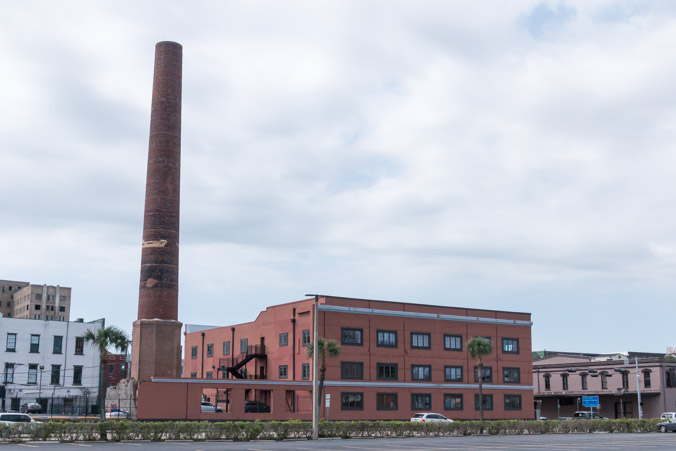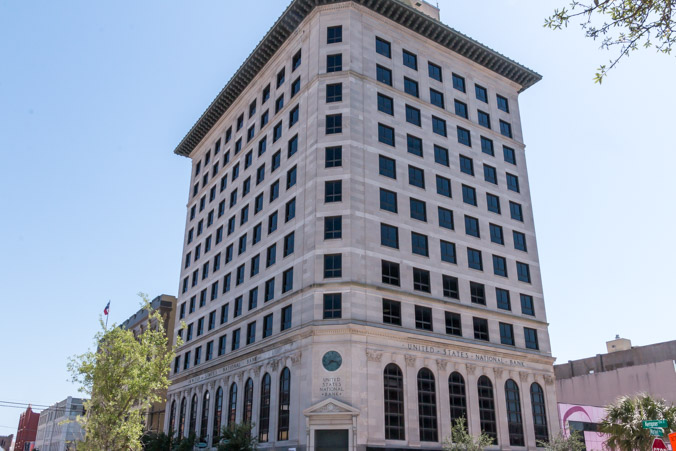
Deepwater Horizon.
Exxon Valdez.
Fracking.
If you’re like me, you don’t give much thought to the oil industry until disaster strikes or a controversial topic comes up in the news. I’m a bit ashamed to admit that I know next to nothing about how petrochemicals are acquired but I do know that they are essential to modern life.
Today we set out to learn what we can at the Oceanstar Oil Rig Museum in Galveston, Texas. We managed to drive right to it today, no detours!
The museum sits in the Port of Galvestion, next to the cruise ship terminals. Shipping industry, oil rigs and other machinery can be seen from the water’s edge.


Old buildings stand across the street, their former lives painted on their sides.


Some are getting new life.

Tickets for the museum can be purchased in the gift shop on the dock. The entrance to the rig is across a gangplank.
Inside a small theater, a short movie which outlines the oil drilling industry and it’s history plays on repeat. The first floor also houses some static displays, pictures, artifacts and interactive exhibits.
The Oceanstar oil rig was built at Bethlehem Steel Shipyard in Beaumont, Texas in 1969. It’s a jack-up rig which can operate in 173 feet of water and is designed to drill a well to 25,000 feet. When it was active, it drilled in the Gulf of Mexico and was decommissioned in 1984.
The first thing I learned about oil rigs is that there’s more than one kind, some are fixed in place, some have an island, some float, some are anchored and some are connected by umbilicals.
The jack-up rigs, like Oceanstar, are pictured above, sitting in the port with the towers sticking up. To get to the drilling site, the rig is either towed or has it’s own propulsion. Once there, those “towers” which are actually legs, lower into the water until they meet the ocean floor. Then they “jack” the rig up out of the water, at least 25 feet, to provide a stable platform which is unaffected by wave action. Once stable, the rig is ready to drill. The world’s jack-up fleet is 357 units. Crew size varies but the Oceanstar had quarters for 49 persons.
I’ve always had a deep respect for people who do difficult and dangerous work but I have to admit a new appreciation for the men and women who work on oil rigs based solely on the way they commute.
Meet the Personnel Basket.

The crew, arriving by boat, has this contraption lowered down to them. They toss their belongings inside the net, step onto the orange ring, hang on to the OUTSIDE of the net while a crane swings them up and over the ocean (none to gently in my opinion) and onto the platform. No thanks!
The museum itself is a beautifully appointed space with interesting and engaging exhibits throughout.

Drill bits arranged like art are strangely intriguing.

People learn differently. Some people are tactile, they need to touch and manipulate things in order to fully absorb the knowledge. Some use hearing, some can read and remember and some are visual, they need to see exactly what was explained in order to understand it. I fall into that category. This museum was perfect for me in that sense. They had videos of undersea drilling, animations, dioramas and models, actual oil rig machinery and so on.
The models in the pictures below were astounding to me. I had a picture in my mind of an oil rig drilling down in one spot and sucking oil out.
I never thought beyond that
Or if we’re really honest I never gave it much thought at all.
I certainly never thought about drills bending to follow deposits.

And I definitely never thought that multiple wells and lines spread out in an underwater field could feed one rig.

Now that I see it, it makes perfect sense.
I’ve always been fascinated by divers and diving so the ORV and diving exhibit was a favorite of mine.



Venturing outside onto the lower deck we were astounded by the height of the drilling scaffold and how crowded with machinery the deck was.




A lot of things to keep track of on this old panel.


If anything goes wrong this is your best friend!




Someone is working hard!
 Back inside, the second floor houses more exhibits and a huge diorama of the ocean with different types of rigs which might be found there. The diorama is two stories tall, visible from windows which show “underwater” and visible from above which shows the surface view.
Back inside, the second floor houses more exhibits and a huge diorama of the ocean with different types of rigs which might be found there. The diorama is two stories tall, visible from windows which show “underwater” and visible from above which shows the surface view.


Pictured below is a link from one of the multiple chains which might anchor a floating oil rig to the seabed. The statistics of how many chains and how far they can stretch will blow your mind!

Many of the tools used in the procuring of petrochemicals and the processes developed are intricate and fascinating and some are admittedly over my head!


Comfort and safety of personnel is explained in the living quarters of the rig.




One of the most impressive parts of this museum are the hundreds of meticulous models on display. Models of ships, oil rigs, support vehicles, tools and equipment.

This model of an oil platform is next to impossible to photograph. It is huge! It fills an entire corner of the room, thousands and thousands of tiny parts. It is as intricate and complete a model as I’ve ever seen.


Even the smaller and less intricate models are carefully crafted and displayed.
Overhead, a running display board lists the prices of every support vehicle associated with an oil rig.
I caught it in the lower numbers, the costs went up and up!

Outside, on the top level.

Looking down to the main deck.

Looking out at the dock.

Looking up underneath the drill scaffold.
Knobs and dials and parts galore!
We’ve learned all we can about the oil industry for one day. The information is extremely interesting and more complex than I would ever be able to convey, but I feel that we have gained a deeper appreciation for the lives and work these men and women do. There is no denying that the products they obtain make modern life possible. I can only pray that the human race will be good stewards of the resources we are given, including oil products.
It’s time for lunch.
We’re parked in a pay lot at the dock.
It’s not too far to walk into downtown to find food.

Sights along the waterfront.
Boy With Seagulls.
The waterfront is home to many businesses. They offer a greek restaurant, a steak house, gift shops and the 1877 Tall Ship Elissa, (which offers tours but was gone on this day).
Pier 21 theater shows historic movies. The Great Storm, the story of the 1900 hurricane, The Pirate Island of Jean Laffite and a documentary called Galveston-Gateway on the Gulf.
The port has seen some history.

Heading toward downtown, The Strand is the historic district’s shopping mecca. Many of the buildings survived the hurricane of 1900.


A lot of the shops here are similar to those on Hollywood Blvd. or Southern California beach towns. They sell funky tee shirts, and touristy knick knacks.



After wandering around a bit and turning onto side streets, we discovered an interesting sight.
Po Boys Restaurant.


The inside is even better!
The food was great! I had the 1/2 chicken and Jeff had a burger.

Fully satisfied, we continued sightseeing.

The old buildings continue to amaze.

The art deco details and medallions on the very top are beautiful. The building is so tall, it’s hard to see. They paid such attention to detail and quality back then.

It’s looking a little sad, I hope they restore it.

The details are everywhere.
The Grand Opera House, it’s all in the entrance.


The modern buildings are interesting in their own right. This one stands on stilts. The stilts are incorporated into the design. It’s amazing how tall it is and how narrow a support system it seems to have.

Some of the buildings have plaques nearby which explain their history, ownership and construction styles.


Some have dates incorporated in the design.





Large and small, old and new, incredible sights all around.



This little bank is a historical museum but it was closed due to road construction.
When we came across an old fashioned soda shop and candy store we decided it needed a closer look.




Two thumbs up!
On the way back to the parking lot, near the cruise terminal we found a couple of tourist attractions, both closed.

We weren’t quite ready to call it a day so we decided to drive around near the beach to look at houses.
We’d noticed one thing about Galveston from the day we arrived.
Drainage ditches everywhere.
Drainage ditches run along every street on the island. To access a house requires driving over a narrow “land bridge” driveway. Cars are constantly getting stuck in the ditches. When we first arrived at the RV park, a tow truck was dragging a car out of the ditch next to the park.
That’s why we weren’t surprised to see a small pickup truck stuck with his front wheels in a ditch and the truck high-centered on a driveway. We stopped to offer some help to the young man and his pregnant wife. He told us he was a contractor who came to look at a job and miscalculated as he backed up. Jeff hooked up the tow straps and we pulled him out. They were both very grateful.
We were happy to be in the right place at the right time!
A divine appointment.

A great note to end the day on!











